In one sense, it is surprising how much successful science there is given that we find it so difficult to come up with an account of what scientific knowledge is - at least an account that is moderately general and correct.
Perhaps doing science is like riding a bike - thinking deeply about the process, as opposed to the performance, just does not help. Nonetheless, Mary Morgan and Margaret Morrison, the editors of this multidisciplinary collection, seem to want us to have a go with this book that offers a well-crafted set of case studies attempting to explicate how scientific models mediate between theory and the world.
The book's organising thesis is fleshed out in chapter two, written by the editors. Morgan and Morrison summarise the elements of their account as being about construction, functioning, representing and learning.
On construction, the editors note that the literature is somewhat quiet, though they point to work by Mary Hesse on analogies and Nancy Cartwright on her simulacrum account of models. They do, however, offer evidence to indicate that in physics and in economics, models are syntheses of disparate elements - formulae, theory fragments, empirical evidence and some element of interpretation. When it comes to learning, one of the editors claims that "we do not learn much from looking at a model - we learn more from building the model". This latter theme is developed in the concluding chapter, and while it is right to stress the issue, I was surprised that no reference was made to the work of operations researchers or of Larry Phillips, whose concept of requisite decision modelling develops this idea to its logical and practical conclusion.
The function of models is a well-chewed topic, and the three functions identified here offer few surprises. For instance, that models are used to explore and develop theory seems a claim that will not usefully be contested. That models provide a framework for measuring things is less obvious, but the distinction it gives rise to, between precision (determined by sophistication of apparatus) and accuracy (determined by the model used) looks helpful and merits further unpacking.
The use of models for design and intervention comes last, and though this positioning probably reflects well the individual motivational priorities of many good scientists, it rather downplays the institutional and historical reasons for their patronage. Manipulation, or at least manipulability, is central to both intervention and theorising, and I did wonder if linking this primarily to intervention served to underestimate its importance.
The various contributed chapters flesh out the themes usually by offering views about the functions and definitions of models. For reasons only of space, I concentrate on three that I found particularly useful.
Marcel Boumans's chapter looks at model building as an act of synthesis. The proposal is interesting because the analysis of integration is of growing interest in economics and social science and because the examples, from mathematical models of macro-economic behaviour, seem to demonstrate Boumans's characterisation rather neatly.
Boumans also pulls out two consequences worth noting. In the first instance, we must expect, he posits, to see a certain amount of "mathematical moulding": formalism is not just an ontologically neutral device but one that makes some things easy to say, and others difficult. Second, if a model is a synthesis of theory and evidence, then justification is built into the design - a simple point with profound consequences for how we think about theory testing and the role of statistics.
Having shared similar views on the links between rational choice and transitive preference (more precisely their absence), I was particularly interested in the chapter by R. I. G. Hughes, wherein he teases out relations between computer simulation in physics and a general account of theoretical representation. Centred on examples that include work on the Ising model and critical-temperature phenomena in a variety of physical systems, Hughes offers a view of theoretical representation based on "the premise that the function of a model" is to denote elements of the subject in the world, demonstrate consequences of particular sets or sequences of events and to provide an interpretation of the same.
The subject is novel and the thesis I would accept in many respects, though one might question the importance that Hughes places on "obvious correspondence" - a criterion he cites as being capable of determining whether a computer simulation can really be thought of as a physics experiment. Hughes's four examples towards the end of his paper seem consistent with the statistical notion of an experiment, based on the idea of isolation and control. Clearly denoting things does not require obvious similarity and just as equally all computer simulations do imply control, usually by the bucketload.
Finally, I mention the chapter by Ursula Klein, research director of the Max Planck history of science unit in Berlin and a specialist in the history and philosophy of chemistry. Her object of study is how 19th-century chemists came to use the quasi-algebraic notation introduced by Berzelius as a way of extending the concepts of inorganic chemistry to the study of organic compounds. Inter alia, she finds evidence of resistance to the formalism by mathematicians who thought it a caricature and by Dalton on the grounds that it was insufficiently interpreted. But it was this lack of interpretation that helped the Berzelian algebra find a variety of useful applications. The parallels with mathematics in economics are uncanny, and the whole episode seems to sum up the schism between abstractionists and the empirically minded that dogs many academic disciplines.
Chapters by Mauricio Suzarez, Geert Reuten, Nancy Cartwright, Adrienne van den Bogaard and Stephan Hartmann fail to get the coverage they too deserve in this review only for reasons of space.
Do I have any qualms? There is a sense in which the editors see models as having "a life of their own", which is fine, so long as we regard this ascription figuratively. But they say models can function autonomously in a way that comes close to ascribing agency to the models, and I was not sure how far the reader was supposed to follow the implications of this metaphor. Second, there is something unresolved about the book's underlying thesis as well as its relation to this collection of case studies. That models mediate between theory and the world does not, of itself, tell us very much, and the claim that their independence of theory and the world is what allows them to do this is more often stated than argued for.
Nevertheless, this is an important book, for it shows that discussions about the philosophy of science, which take physics and economics together, are perfectly plausible, can be made with sophistication, and that the methodology this implies provides a welcome check on the generalisation of claims about scientific theories that really only apply to a single discipline. Furthermore, it directs our attention towards the role of models in science and potentially provides a bedrock for future work that looks not at theory, evidence and their links, but takes a more naturalistic and rounded picture of their interaction and synthesis.
Paul Anand is director of research in economics, the Open University.
Models as Mediators: Perspectives on Natural and Social Science
Editor - Mary S. Morgan and Margaret Morrison
ISBN - 0 521 65097 6 and 65571 4
Publisher - Oxford University Press
Price - £42.50 and £15.95
Pages - 401
Register to continue
Why register?
- Registration is free and only takes a moment
- Once registered, you can read 3 articles a month
- Sign up for our newsletter
Subscribe
Or subscribe for unlimited access to:
- Unlimited access to news, views, insights & reviews
- Digital editions
- Digital access to THE’s university and college rankings analysis
Already registered or a current subscriber?



